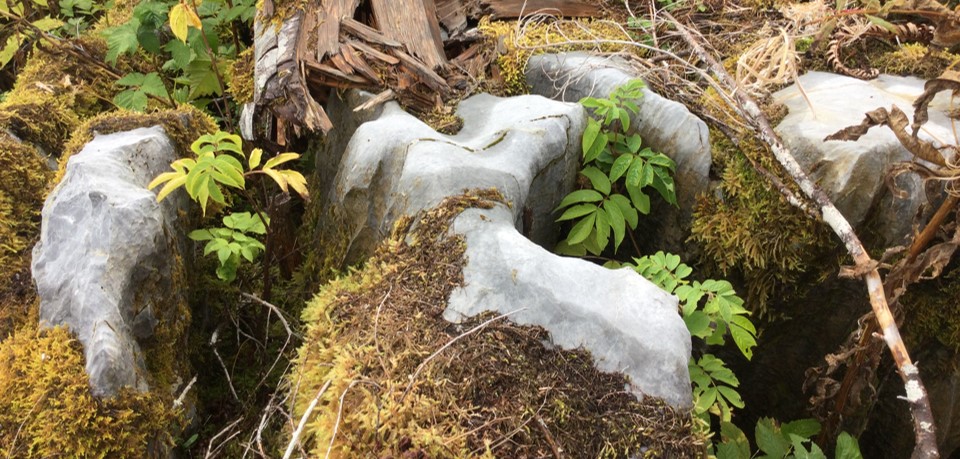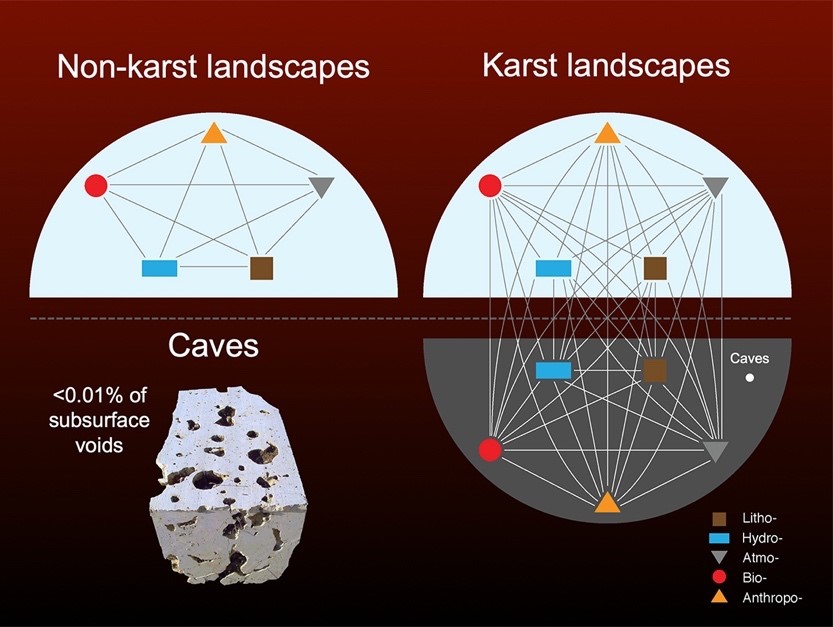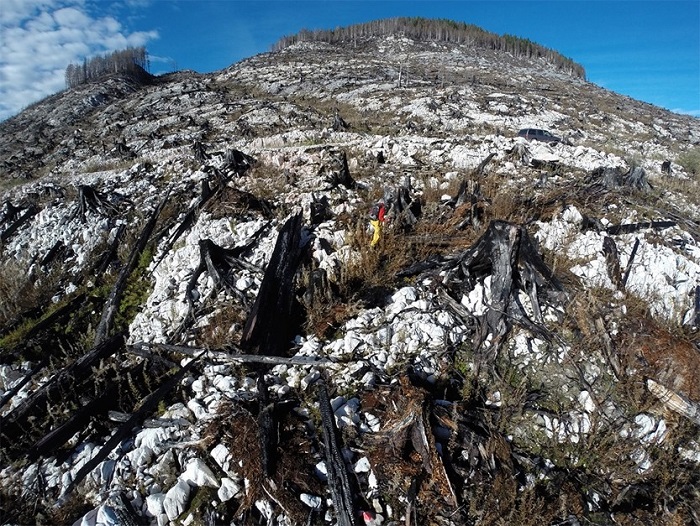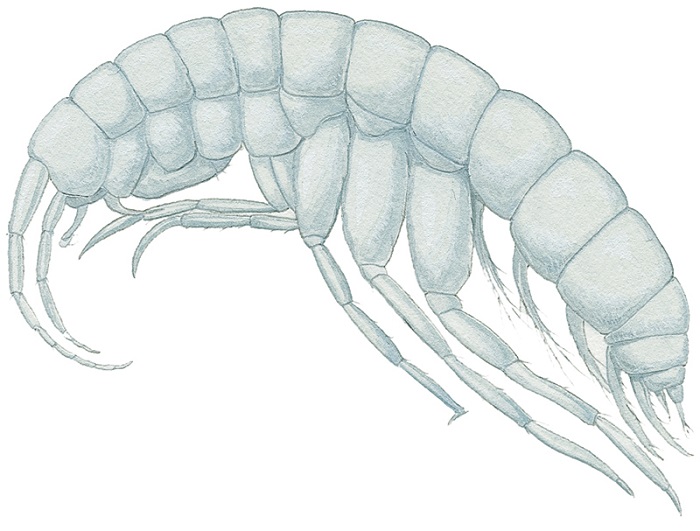Lesson 5: What Makes Karst Sensitive and Vulnerable to Disturbance?

On this page
- Lesson objectives
- Soil loss
- Geomorphic hazards
- Changes to karst hydrological regimes
- Water quality issues
- Loss of biodiversity
- The sensitivity of caves and their contents
- Lack of knowledge
- Test your knowledge
Lesson objectives
Karst is recognized as one of the most sensitive ecosystems on the planet. The focus of this lesson is to discuss the sensitivity of karst and its vulnerability to disturbances.
The “sensitivity” of karst can be defined as the intrinsic natural susceptibility of karst to change independently of external factors such as land use. The “vulnerability” of karst can be defined as the susceptibility of karst to change caused by external natural or human-caused disturbances.
At the end of this lesson, you should be able to:
- Explain why karst is especially sensitive
- List some of the reasons why karst is vulnerable to disturbance
- Describe some of the ways that land-use disturbances affect karst
Factors that make karst especially sensitive include:
- The porous surface of karst and the solutionally enlarged fissures and joints within the bedrock matrix allows liquids and fine materials on the surface to move into the subsurface. Once liquids or fine materials enter the subsurface, they can be transported throughout the karst system and to downstream locations.
- Hydrological regimes and geochemical processes in karst are linked and strongly mediated by surface (and in some cases subsurface) biota. Disturbances to the biotic components of karst, especially those on the surface, can therefore directly affect the hydrology and the geochemical processes within karst systems.
- The physical heterogeneity and geochemistry of karst, both surface and subsurface, often creates specialized habitats or niches. These can be colonized by rare or endemic species or unusual assemblages of species that are highly adapted to specialized conditions and cannot migrate or survive if those conditions are altered.
In karst, the effects of human-caused disturbances have the potential to combine, be magnified, and extend far into the complex interconnected subsurface. This can result in far-reaching impacts that would not occur to the same extent in non-karst areas.

The graphic above illustrates the complexity of karst landscapes compared to non-karst landscapes. The basic environmental components of non-karst and karst landscapes are the lithosphere, hydrosphere, atmosphere, biosphere, and human activities. Caves may represent <0.01% of all subsurface voids in karst. [Illustration by P. Griffiths adapted from Andreychouk (2016)].
The sensitivity and vulnerability of karst is a complex topic. At this introductory level, detailed treatment of this topic is not practical; nevertheless, this lesson will touch upon some key points.
Some of the management concerns associated with karst are summarized below:
- Soil loss
- Geomorphic hazards
- Changes to karst hydrological regimes
- Water quality issues
- Loss of biodiversity
- The sensitivity of caves and their contents
- Lack of karst knowledge
Soil loss
Soils in karst areas tend to be thin and residual with low nutrient availability. They are not easily replaced because the only source of sediment can be the very limited amount of insoluble residue in the underlying bedrock. The inorganic parts of karst soils can often develop only from the residues remaining after bedrock dissolution in very pure limestones. Less than 1% of the original rock mass in some karst areas may be available to form soil. In many karst areas, the “soil” consists of a thin mat of organic material. When deep soils are present in karst areas, the sediments were often transported from non-karst areas to the karst by glaciers, rivers, or gravity.
The surface permeability of karst makes it susceptible to the vertical transfer of eroded soils and sediments into grikes, enlarged fissures and joints, and cavities including enterable caves. Furthermore, soil and nutrients can be easily transferred vertically past the rooting depth of plants growing in karst.
Negative relief features in karst are predisposed to soil mass movements when disturbed and can concentrate timber harvesting debris that can migrate from the perimeter by gravity forces.
Soils in karst areas are often susceptible to erosion particularly if the natural vegetation is disturbed. Removal of the forest canopy in high rainfall areas can lead to erosion and relocation of soil into the karst subsurface. Vegetation helps to protect and anchor soils in place to prevent them from being washed into openings and transported through the karst system.
Karst differs from other landscapes in that soil erosion can occur in locations where the overall terrain slope is level and free of any surface runoff and streams.
If the vegetation and soils are severely disturbed, the karst surface can become rocky and less productive while portions of the subsurface can become choked with vertically transported sediments. Around the world, there are many examples of this kind of “rocky desertification” in formerly forested karst areas. There are examples of rocky desertification in coastal B.C. Exposed roots and outcroppings of rundkarren (rounded solution grooves usually formed under soil) are often the first evidence of soil loss that can occur after timber harvesting.

In some circumstances, when a wildfire burns over a previously harvested area on karst terrain, soil loss can result. The above photo depicts the resulting soil loss on a cutblock in coastal B.C. after a wildfire. Due to the presence of logging debris and increased desiccation when overhead shade is removed, wildfires on recently logged karst landscapes can be more intense than fires on unlogged forests, and can result in almost complete loss of soil cover. Fires on karst may also be aerated through the openings in the underlying bedrock to produce more intense burns. Organic compounds can be volatilized, and remaining materials can be transferred to the subsurface through open fissures and cavities. (Photo by P.A. Griffiths)
Photo above: Example of thin soil cover on karst (Photo by C.L. Ramsey)
Once it occurs, soil loss in karst areas can be difficult or impossible to reverse. As soil levels and productivity decrease, a positive feedback loop is established that can further diminish productivity and biodiversity.
Did you know? The Kras plateau or “Classical Karst” is a landscape covered by dry shrubland and rocky outcrops, but prior to the Neolithic period (about 8,500 to 8,000 years ago), much of this area was covered by dense forests. As the region became more densely settled, people began to clear and burn land for pastures and grazing animals. The wood from the forests provided lumber for building and trade.
Over the centuries, these human land-use activities on well-developed karst, coupled with regional climatic conditions, combined to produce soil loss and the dry, rocky landscape we associate with karst today. Since the 1850s, efforts to reforest parts of the Kras plateau have been underway. Grazing was banned in the middle of the last century, yet the native forests have not been able to regenerate to their original state, and some areas of the plateau continue to exhibit rocky desertification.
Geomorphic hazards
The collapse of bedrock or unconsolidated sediments into underlying bedrock cavities, including enterable caves, is a greater potential hazard in karst landscapes as opposed to non-karst areas.
Human-induced changes to groundwater levels and circulation in karst can create conditions more favourable for collapse or subsidence.
Induced development of alluvial dolines (karst sinkholes) in karst landscapes can expose cavities and subsurface waterbodies.
The topographic complexity of well-developed karst landscapes makes them prone to surface damage caused by breakage when hand-felling large trees. The roughness of these karst landscapes, along with generally thin soil and rock protuberances also means they can be more easily damaged or disturbed by the travel of heavy machinery.
Toppling and uprooting of large trees by wind forces can damage epikarst and cause soil loss into solution features. Harvest openings and road right-of-way edges can create conditions favourable for rotational tree windthrow events.
Karst is more vulnerable to impacts of quarrying than non-karst because the subsurface of the karst landscape hosts complex habitat and biodiversity elements that are destroyed in quarrying processes. The extent of vertical and lateral impacts caused by quarrying is potentially greater in karst because of the atmospheric and hydrological networks in the bedrock.
Karst is generally more vulnerable than non-karst to road building involving excavation and blasting for similar reasons. In addition, roads on karst impose an impermeable surface on a naturally permeable terrain, disrupting natural drainage patterns. Roadbed materials can also be lost to underlying solution openings in karst.
Apart from rare major earthquakes or large rock slumps along dip slopes, the natural geomorphological changes in non-karst areas are very gradual compared to those that can occur in karst landscapes. Landslides originating in non-karst areas can sometimes spill sediments onto the karst. The sediments can then be transferred into subsurface cavities, including enterable caves.
Changes to karst hydrological regimes
The health of karst ecosystems can be compromised by changes to hydrological regimes – i.e., the quantity, speed, location, and timing of water inputs and outputs in a karst system. Hydrological changes can negatively affect karst habitats and biodiversity and/or impact natural karst processes or degrade karst system elements and values.
The permeability of karst due to dissolution cavities and fissures is much greater than in the generally less fractured bedrock or granular aquifers of non-karst landscapes. Concentrated surface flows common in non-karst areas are uncommon in karst because the permeability of the karst surface allows precipitation to drain directly into the epikarst. Karst landscapes can also have many negative relief features with direct subsurface drainage connections.
The timing, rate, and amplitude of rising and falling groundwater levels in karst can be further increased by changes to inputs of water caused by land cover changes. Water levels can rise very rapidly for up to tens or even hundreds of metres in karst depending on the characteristics of the karst system. Groundwater levels in karst can also vary greatly over short distances and time intervals.
Karst areas with thin soils and limited water-holding capacity can be more prone to seasonal drought because the rainwater infiltrating the land surface is not detained for long. Water freely drains into underlying fissured and jointed bedrock. Removal of the forest canopy and the loss of shading in karst areas can aggravate drought conditions during hotter dry periods by raising soil temperatures and increasing soil water evaporation rates.
Translocated soils, sediments, and fine logging debris can rearrange or otherwise alter flow patterns in the many subsurface conduits and other cavities that do not exist in non-karst landscapes. This can also affect the geochemistry, ecology, and biodiversity of the subsurface karst environment.
The distribution and hydraulic characteristics of diffuse water input in karst (autogenic recharge) can be strongly affected by human activities such as the removal of vegetation. The effects of surface disturbances in karst can disperse vertically and laterally throughout the subsurface. Reaction times to changes in sediment inputs, and water quality and quantity, can be very short.
Alteration and/or contamination of hydrological inputs in karst can directly impact the quality and quantity of karst spring outflows important to downstream aquatic communities or people. Aquifers and springs in non-karst areas are generally not as susceptible to surface disturbances and contaminants are less rapidly dispersed.
Blind valleys and stream sinks are distinctive karst features that can create conditions for back-flooding events. Human-induced changes to contributing water flows and/or complete or partial obstruction of the sink points with debris can cause back-flooding events. The blockage of stream sinks can also cause the streams to alter their natural subsurface flow paths.
Water quality issues
In the previous lesson, we learned that karst provides drinking water to about a quarter of the world’s population. The vulnerability of karst aquifers to contamination or pollution is therefore another important management concern. Three factors make the water in karst systems especially vulnerable to contamination or pollution:
- The permeability of the karst
- Rapid transit times for water moving through the karst
- The lack of purification capacity in karst aquifers (groundwater systems)
Contaminants or pollutants that may be unintentionally spilled or purposely applied on the surface can seep into the porous epikarst (the upper layers of karst), even where visible surface flows are absent. Chemical spills, the introduction of pollutants, rapid soil loss, or other disturbances on the surface of the karst can have impacts that negatively affect the karst system at depth. Road run-off channeled onto the epikarst or into features like dolines (karst sinkholes) can also carry both sediments and hydrocarbon residues into the karst subsurface. A hydrocarbon spill in karst can disperse more rapidly and for greater distances than the same spill in non-karst terrain. Spills on karst are also less recoverable from bedrock openings.
In the karst subsurface, mechanisms for filtering or purifying the water are limited and the speed of transport leaves little time for contaminants to degrade. The natural purification or attenuation processes present in non-karst aquifers are often limited in karst. Fuel, pesticides, herbicides, agricultural wastes, and other pollutants applied or spilled on the surface in one part of a karst system can be rapidly transported to drinking water source areas, with consequences for human health as well as aquatic communities within and/or downstream of karst systems.
Contamination of karst waters can also occur when contaminants or pollutants from land-use activities in upland non-karst areas are transported to the karst by surface flows. Once those flows enter the karst subsurface, they can be rapidly transferred vertically and laterally through the karst and emerge unexpectedly in places far from their point of origin – sometimes even in a different watershed. The travel velocity of water in karst hydrological systems can be up to hundreds of metres per hour.
Conventional watershed analyses will not necessarily show where pollutants will emerge once a karst aquifer is contaminated, since karst systems may not be confined by typical topographical drainage patterns and subsurface drainage divides in karst can overlap. Surface land-use activities on either karst itself or any contributing non-karst catchment areas therefore require careful planning as well as a good understanding of the total karst catchment area. Dye tracing and modelling by specially trained karst hydrologists is an essential first step toward understanding the potential subsurface flow paths of water in karst systems.
The video linked below – titled “ŽIVO: Life and Water in the Karst Region” was produced as part of a cooperative project carried out by karst scientists in Croatia and Slovenia. It provides clear explanations and illustrations of why karst water is especially vulnerable to contamination. Although its geographic focus is transboundary karst aquifer management issues in the region of Northern Istria, it illustrates basic concepts about karst hydrology that are applicable in B.C. as well. This video also illustrates one aspect of the many kinds of work and research that karstologists undertake.
Click here to view "ŽIVO: Life and Water in the Karst Region" video.
Did you know? In May 2000, the municipal wells of Walkerton, Ontario became contaminated with pathogenic bacteria, resulting in seven fatalities and illnesses in 2,300 people. The incident was highly publicized at the time. What is less well-known is that it was an example of how karstified carbonate bedrock with rapid groundwater velocities may be highly vulnerable to contamination.
Loss of biodiversity
Karst environments tend to be “hot spots” for biodiversity. The three-dimensional character and physical heterogeneity of karst create a diversity of both surface and subsurface microhabitats with unique and distinctive assemblages of organisms that can be rare or absent from surrounding non-karst landscapes.
The amount of light falling onto different karst system elements (e.g., enlarged fissures and joints, grikes, dolines, springs, or cave entrances), and the temperature and humidity conditions at these features, provide important “natural habitat islands” or microclimatic refugia for plants or animals that may be unable to survive in other environments. For example, some plants are adapted to karst sites with exposed bedrock and thin, well-drained soils.
Preserving habitat diversity in karst depends largely on maintaining the natural hydrological, biophysical, and chemical properties of the landscape, which in turn are highly dependent on the maintenance of vegetation and soils. Human activities can easily disturb the temperature, humidity, and light conditions that support species adapted to surface and subsurface karst habitats.
Subsurface karst habitats are generally very low biomass environments with biodiversity and ecological processes largely dependent on energy and food resources arriving from the surface. The terrestrial and aquatic organisms that live underground may have a lower ability to cope with significant shifts in environmental conditions and inputs. These organisms can have low metabolic rates and reduced fecundity (ability to reproduce).
Compared to non-karst landscapes, the potential for disturbance to subsurface ecohydrology is more direct in karst due to the many surface-subsurface connections. Karst cavities, including enterable caves and their biota, are susceptible and responsive to activities on the surface. The disruption of soils and vegetation can affect hydrology and energy and organic inputs from the surface.
Due to the relative invisibility of subsurface karst habitats, they often tend to get overlooked from a land management perspective.
Subsurface environments are not the only karst components where biodiversity presents management concerns. Karst also has so-called “transition zone” habitats around springs, cave entrances, and even in grikes where temperature, light and shade conditions may require additional management considerations.
Organisms that become highly adapted to karst environments may not be able to easily migrate away or adapt if conditions in their karst habitats change too much due to disturbances. In this sense, karst may be considered a type of “island ecosystem.” Managing karst biodiversity is therefore predicated on:
- Karst is finite and fixed in space
- Managing karst requires a precautionary approach to minimize potentially detrimental changes to karst habitats
The sensitivity of caves and their contents
Much of the karst subsurface consists of stable low energy environments, except for cave passages or cavities that carry running water for at least part of the year. The lower energy subsurface karst environments and the values associated with them tend to have low resilience to disturbance.
Caves can have sensitive resource contents that are especially vulnerable to damage, including delicate cave formations, cave-adapted organisms, or palaeontological material. Caves can also be important cultural or sacred spaces.
Evidence of human visitors to caves can last for many thousands of years. It only takes seconds to accidentally break, crush or mar cave formations that have taken thousands of years to form, trample cave-dwelling organisms and their habitats, or disturb paleontological materials. Even the most careful human visitors may unwittingly introduce microplastics, other foreign matter, and pathogens into caves.
Prospective cave visitors should assume they will leave impacts, and that the wear and tear will be both cumulative and long lasting. Consider that human footprints in Chauvet Cave in southern France are estimated to be about 30,000 years old. It’s a reminder that visitors to caves should carefully weigh their need to enter against the consequences of doing so.
As discussed earlier in this section, caves and other karst cavities can also be vulnerable to surface disturbances.
The image to the right depicts the amphipod crustacean Stygobromus quatsinensis found in some caves in coastal B.C. and Southeast Alaska. (Image credit M. Nyhof). These organisms range in size from 5 to 7mm.

Lack of knowledge
One of the biggest threats to karst is a lack of understanding that it is a complex ecosystem with linked surface and subsurface components.
Unintentional outcomes such as soil loss, water contamination, or a decrease in biodiversity can result when approaching land-use activities in karst as if it were a landscape like any other. Managing karst successfully begins with understanding what it is, how it works, and why it is sensitive and vulnerable to disturbance.
It is essential that management decisions be based on knowledge about the functioning of karst ecosystems and the fundamental role of soil and vegetation cover in karst processes.
Test your knowledge
Self-test (True/False)
Answer either True or False to check your understanding:
1. Karst is especially sensitive because of the porous surface, the solutionally enlarged fissures and joints within the bedrock matrix , the way that the surface biota mediates hydrological regimes and geochemical processes, and the physical heterogeneity and geochemistry of karst (surface and subsurface).
2. Soil erosion on karst landscapes can occur in locations where the overall terrain slope is level and free of any surface runoff and streams.
Answers
1. True. The porous surface of karst and the solutionally enlarged fissures and joints within the bedrock matrix allows liquids and fine materials on the surface to move into the subsurface. Once liquids or fine materials enter the subsurface, they can be transported throughout the karst system and to downstream locations. Disturbances to the biotic components of karst – especially those on the surface – can directly affect the hydrology and the geochemical processes within karst systems. Further, the physical heterogeneity and geochemistry of karst – both surface and subsurface – often create specialized habitats or niches. These can be colonized by rare or endemic species or unusual assemblages of species that are highly adapted to specialized conditions and cannot migrate or survive if those conditions are altered.
2. True. Karst differs from other landscapes in that soil erosion can occur in locations where the overall terrain slope is level and free of any surface runoff and streams. Karst landscapes can be vulnerable to soil loss because soils tend to be thin and the surface permeability make it susceptible to vertical transfer of eroded soils and sediments into grikes, enlarged fissures and joints and cavities. Negative relief features in karst are predisposed to soil mass movements when disturbed and can concentrate timber harvesting debris that can migrate from the perimeter by gravity forces. Vegetation helps to protect and anchor soils in place to prevent them from being washed into openings and transported through the karst system Soils in karst areas are often susceptible to erosion particularly if the natural vegetation is disturbed. Removal of the forest canopy in high rainfall areas can lead to rapid erosion and relocation of soil into the karst subsurface.
